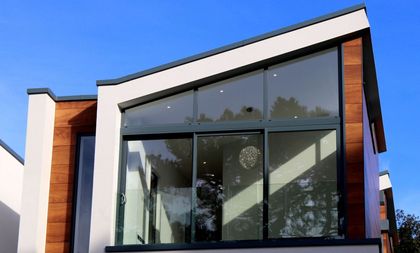Just How Residential Window Tint Can Decrease Power Costs
Just How Residential Window Tint Can Decrease Power Costs
Blog Article
How Residential Home Window Tinting Enhances Your Home's Power Effectiveness
Residential home window tinting offers an engaging remedy for property owners looking for to boost power efficiency within their living rooms. By applying specialized films to windows, it successfully lowers heat transfer, therefore stabilizing indoor temperatures and lessening the demand for too much home heating or cooling.
Understanding Window Tinting
Understanding window tinting is important for house owners looking for to boost both convenience and power effectiveness in their living spaces. Residential Window Tint. Window tinting involves the application of a thin film to the inside or exterior surface of glass windows. This film can considerably modulate the amount of sunshine and warm that goes into a home, hence affecting interior climate conditions
There are numerous sorts of home window tinting films available, each with unique properties. Dyed films soak up solar power, while reflective movies disperse it away from the glass surface area. Ceramic movies use a balance of visibility and warmth denial, making them a preferred option among homeowners. The efficiency of home window tinting is often gauged by its Visible Light Transmission (VLT) percent, which suggests just how much light can pass with the film.
Benefits of Power Effectiveness
Window tinting not just boosts looks but additionally plays a substantial function in improving energy effectiveness within domestic rooms. By minimizing heat transfer with windows, colored movies produce a more secure interior environment, which can result in significant decreases in power intake for home heating and air conditioning. This energy effectiveness equates right into lower energy costs, providing homeowners with significant lasting savings.

Additionally, home window tinting enhances the convenience of living rooms. By minimizing glare and blocking dangerous UV rays, tinted home windows produce a more pleasant environment, which can cause improved wellness for passengers. The security against UV rays also helps maintain furnishings and floor covering from fading, adding to the longevity of home items.
Exactly How Tinting Works
Tinting movies run via a combination of sophisticated materials and modern technologies designed to control the quantity of solar energy going into a home. Primarily composed of polyester, these films typically integrate ceramic or metal fragments that soak up and reflect warmth. This dual ability allows them to substantially reduce the penetration of ultraviolet (UV) rays and infrared radiation while allowing noticeable light to go through.
The performance of window tinting is gauged by its solar heat gain coefficient (SHGC), which suggests just how much solar power is sent via the home window. Reduced SHGC values are more suitable as they represent greater warm rejection. In addition, window tints can include a variety of tones, permitting property owners to tailor their visual preferences while improving power efficiency.
Additionally, these films function as an obstacle, preventing warm loss throughout cooler months by reflecting interior warmth back right into the home. This thermal insulation impact matches the air conditioning advantages obtained during warmer months, adding to a balanced indoor climate year-round. By handling solar power effectively, household window tinting not only enhances comfort but also plays a vital role in minimizing power intake and reducing energy costs.
Picking the Right Color

There are numerous types of window movies offered, consisting of dyed, metalized, and ceramic. Dyed movies are cost-effective however may have limited durability. Metalized films use far better heat being rejected yet can disrupt electronic signals. Ceramic movies supply excellent warm control without endangering visibility and are highly resilient, making them a preferred choice.
Noticeable light transmission (VLT) is an additional crucial factor, as it suggests the amount of all-natural light that can travel through the colored glass. Home owners need to choose a color with a VLT that complements their illumination choices while still providing sufficient glow reduction.
Furthermore, examining the solar warm gain coefficient (SHGC) can assist figure out exactly how well a color can block heat from sunlight. A reduced SHGC indicates better heat control, ultimately boosting power performance.
Installation and Upkeep Tips
Correct installment and maintenance are essential elements in making the most of the advantages of domestic home window tinting. Professionals additionally use specialized devices and strategies, which can enhance the toughness and efficiency of the color.
Following setup, maintenance is necessary to extend the life blog of the home window movie. It is recommended to wait at least 30 days before cleaning the tinted windows to enable the sticky to treat completely.
In addition, normal inspections are advantageous. Inspect for any type of peeling or bubbling, which might suggest inappropriate installation or wear over time - Residential Window Tint. Dealing with these problems quickly can avoid additional damage and preserve power performance. By sticking to these installment and maintenance suggestions, homeowners can guarantee their home window tinting proceeds to give considerable power financial savings and convenience for many years to find.
Final Thought
In final thought, domestic home window tinting serves as a reliable solution for improving energy efficiency within homes. By minimizing heat transfer and blocking harmful UV rays, window movies contribute to decrease energy usage and boosted indoor comfort.
Home window tinting includes the application of a thin film to the inside or outside surface area of glass windows. By minimizing warmth transfer through home windows, tinted films produce an extra secure indoor environment, which can lead to significant reductions in energy intake for home heating and cooling.The effectiveness of home window tinting is gauged by its solar her response heat gain coefficient (SHGC), which suggests exactly how much solar power is transmitted with the window. By taking care of solar power efficiently, household home window tinting not just boosts convenience yet also plays a vital role in decreasing energy usage and reducing energy expenses.
By lowering heat transfer and blocking hazardous UV rays, window he has a good point films contribute to lower energy consumption and improved indoor comfort.
Report this page